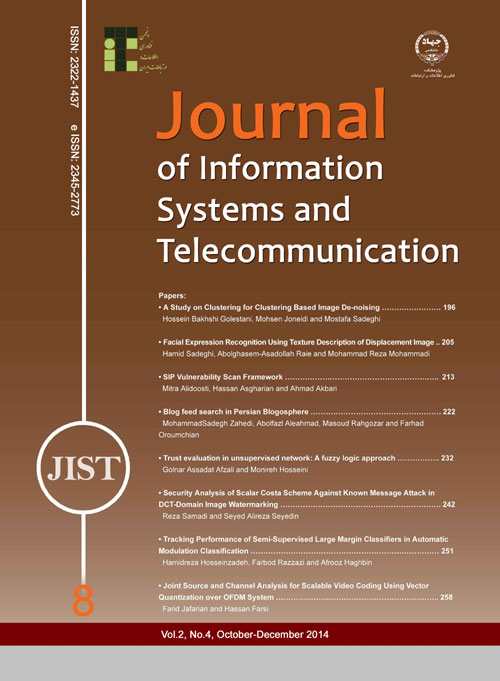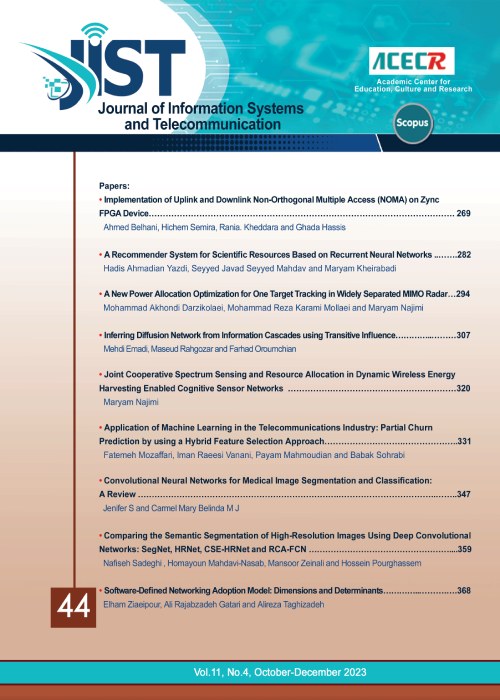فهرست مطالب

Journal of Information Systems and Telecommunication
Volume:2 Issue: 4, Oct-Dec 2014
- تاریخ انتشار: 1393/09/16
- تعداد عناوین: 8
-
-
Page 196In this paper, the problem of de-noising of an image contaminated with Additive White Gaussian Noise (AWGN) is studied. This subject is an open problem in signal processing for more than 50 years. Local methods suggested in recent years, have obtained better results than global methods. However by more intelligent training in such a way that first, important data is more effective for training, second, clustering in such way that training blocks lie in low-rank subspaces, we can design a dictionary applicable for image de-noising and obtain results near the state of the art local methods. In the present paper, we suggest a method based on global clustering of image constructing blocks. As the type of clustering plays an important role in clustering-based de-noising methods, we address two questions about the clustering. The first, which parts of the data should be considered for clustering? and the second, what data clustering method is suitable for de-noising.? Then clustering is exploited to learn an over complete dictionary. By obtaining sparse decomposition of the noisy image blocks in terms of the dictionary atoms, the de-noised version is achieved. In addition to our framework, 7 popular dictionary learning methods are simulated and compared. The results are compared based on two major factors: (1) de-noising performance and (2) execution time. Experimental results show that our dictionary learning framework outperforms its competitors in terms of both factors.Keywords: Image De, Noising, Data Clustering, Dictionary Learning, Histogram Equalization, Sparse Representation
-
Page 205In recent years, facial expression recognition, as an interesting problem in computer vision has been performed by means of static and dynamic methods. Dynamic information plays an important role in recognizing facial expression in the image sequences. However, using the entire dynamic information in the expression image sequences is of higher computational cost compared to the static methods. To reduce the computational cost, instead of entire image sequence, only neutral and emotional faces can be employed. In the previous research, this idea was used by means of Difference of Local Binary Pattern Histogram Sequences (DLBPHS) method in which facial important small displacements were vanished by subtracting Local Binary Pattern (LBP) features of neutral and emotional face images. In this paper, a novel approach is proposed to utilize two face images. In the proposed method, the face component displacements are highlighted by subtracting neutral image from emotional image; then, LBP features are extracted from the difference image as well as the emotional one. Then, the feature vector is created by concatenating two LBP histograms. Finally, a Support Vector Machine (SVM) is used to classify the extracted feature vectors. The proposed method is evaluated on standard databases and the results show a significant accuracy improvement compared to DLBPHS.Keywords: Facial Expression Recognition, Difference Image, Displacement Image, Local Binary Patterns, Support Vector Machine
-
Page 213The purpose of this paper is to provide a framework for detecting vulnerabilities in SIP (Session Initiation Protocol) networks. We focused our studies on the detection of SIP DoS related vulnerabilities in VoIP infrastructures because of their generalization. We try to find weaknesses in SIP enabled entities that an attacker by exploiting them is able to attack the system and affect it. This framework is provided by the concept of penetration testing and is designed to be flexible and extensible, and has the capability to customize for other similar session based protocols. To satisfy the above objectives, the framework is designed with five main modules for discovery, information modeling, operation, evaluation and report. After setting up a test-bed as a typical VoIP system to show the validity of the proposed framework, this system has been implemented as a SIP vulnerability scanner. We also defined appropriate metrics for gathering the performance statistics of SIP components. Our test-bed is deployed by open-source applications and used for validation and also evaluation of the proposed framework. The main contributions of this paper are its non-destructive manner in identifying vulnerabilities and incorporating the penetration testing ideas and steps in the overall architecture of our framework. We also defined appropriate metrics that help us to identify vulnerabilities in a black box penetration testing.Keywords: Vulnerability Scanner, SIP, Denial of Service Attacks, Framework, Evaluation
-
Page 222Recently, user generated content is growing rapidly and becoming one of the most important sources of information in the web. Blogosphere (the collection of blogs on the web) is one of the main sources of information in this category. User’s information needs in blogosphere are different from those of general web users. So, it is necessary to present retrieval algorithms to the meet information need of blog users. In this paper, we focus on the blog feed search task. The goal of blog feed search is to rank blogs regarding their recurrent relevance to the topic of the query. In this paper, the state-of-the-art blog retrieval methods are surveyed and then they are evaluated and compared in Persian blogosphere. Then we introduce our proposed method which is an extension of the voting model that one of the best blog retrieval methods. We have addressed the excessive dependency of the voting model on a list of initially retrieved top N relevant posts by using data fusion methods. Evaluation of the proposed algorithm is carried out based on a standard Persian weblogs dataset with 45 diverse queries. Our comparisons show considerable improvement over existing blog retrieval algorithms. The results show 67% increase in MAP score for the CompVote data fusion method.Keywords: Blog Feed Search, Blog Retrieval, Persian Blogosphere, Voting model
-
Page 232Because of the possibility of anonymity and impersonation in social networks, trust plays an important role in these networks. In social networks, trust can have two aspects: trust of users to social network and trust of users to other users. Pear to pear networks, by eliminating the supervisor roles, besides its benefit in decreasing management costs, have problems in trust and security of users. In these networks, trust evaluation is only related to the trust of pear to other pear and because of the direct relation between pears; each user should know the trust level of other users. However, trust evaluation in pear-to-pear networks (as an unsupervised network), only can be done based on the past relation between pears or trust evaluation of other pears. This kind of trust evaluation cannot give a comprehensive view to pears. In other word, if any pear is not in the friend cycle of a user or friend cycle of user''s friends, he will not be able to assign appropriate trust level to this pear. In this research, by using social networks as supervised networks, trust level of each user is evaluated, then by identifying these users in unsupervised networks, appropriate trust level is assigned to them.Keywords: Trust, Unsupervised Networks, Trust Factors, Fuzzy Logic
-
Page 242This paper proposes an accurate information-theoretic security analysis of Scalar Costa Scheme (SCS) when the SCS is employed in the embedding layer of digital image watermarking. For this purpose, Discrete Cosine Transform (DCT) coefficients are extracted from the cover images. Then, the SCS is used to embed watermarking messages into midfrequency DCT coefficients. To prevent unauthorized embedding and/or decoding, the SCS codebook is randomized using the pseudorandom dither signal which plays the role of the secret key. A passive attacker applies Known Message Attack (KMA) on the watermarked messages to practically estimate the secret key. The security level is measured using residual entropy (equivocation) of the secret key provided that the attacker‟s observations are available. It can be seen that the practical security level of the SCS depends on the host statistics which has contradiction with previous theoretical result. Furthermore, the practical security analysis of the SCS leads to the different values of the residual entropy in comparison with previous theoretical equation. It will be shown that these differences are mainly due to existence of uniform regions in images that cannot be captured by previous theoretical analysis. Another source of such differences is ignoring the dependencies between the observations of non-uniform regions in previoustheoretical analysis. To provide an accurate reformulation, the theoretical equation for the uniform regions and the empirical equation for the non-uniform regions are proposed. Then, by combining these equations a new equation is presented for the whole image which considers both host statistics and observations dependencies. Finally, accuracy of the proposed formulations is examined through exhaustive simulations.Keywords: Scalar Costa Scheme, Known Message Attack, Discrete Cosine Transform, Residual Entropy, Watermarking
-
Page 251Automatic modulation classification (AMC) in detected signals is an intermediate step between signal detection and demodulation, and is also an essential task for an intelligent receiver in various civil and military applications. In this paper, we propose a semi-supervised Large margin AMC and evaluate it on tracking the received signal to noise ratio (SNR) changes to classify most popular single carrier modulations in non-stationary environments. To achieve this objective, two structures for self-training of large margin classifiers were developed in additive white Gaussian noise (AWGN) channels with priori unknown SNR. A suitable combination of the higher order statistics (HOS) and instantaneous characteristics of digital modulation are selected as effective features. We investigated the robustness of the proposed classifiers with respect to different SNRs of the received signals via simulation results and we have shown that adding unlabeled input samples to the training set, improve the tracking capacity of the presented system to robust against environmental SNR changes. The performance of the automatic modulation classifier is presented in the form of k-fold cross-validation test, classification accuracy and confusion matrix methods. Simulation results show that the proposed approach is capable to classify the modulation class in unknown variable noise environment at even low SNRs.Keywords: Automatic Modulation Classification, AMC, Tracking Performance Evaluation, Passive, Aggressive Classifier, Self Training, Semi, Supervised Learning
-
Page 258Conventional wireless video encoders employ variable-length entropy encoding and predictive coding to achieve high compression ratio but these techniques render the extremely sensitive encoded bit stream to channel errors. To prevent error propagation, it is necessary to employ various additional error correction techniques. In contrast, alternative technique, vector quantization (VQ), which doesn‟t use variable-length entropy encoding, have the ability to impede such an error through the use of fix-length code-words. In this paper, we address the problem of analysis of joint source and channel for VQ based scalable video coding (VQ-SVC). We introduce intra-mode VQ-SVC and VQ-3D-DCT SVC, which offer similar compression performance to intra-mode H.264 and 3D-DCT respectively, while offering inherent error resilience. In intra-mode VQ-SVC, 2D-DCT and in VQ-3D-DCT SVC, 3D-DCT is applied on video frames to exploit DCT coefficients then VQ is employed to prepare the codebook of DCT coefficients. In this low bitrate video codecs, high level robustness is needed against the wireless channel fluctuations. To achieve such robustness, we propose and calculate optimal codebook of VQ-SVC and optimal channel code rate using joint source and channel coding (JSCC) technique. Next, the analysis is developed for transmission of video using an OFDM system over multipath Rayleigh fading and AWGN channel. Finally, we report the performance of these schemes to minimize end-to-end distortion over the wireless channel.Keywords: Vector Quantization, Joint Source, Channel Coding, Video Coding, Wireless Channel


